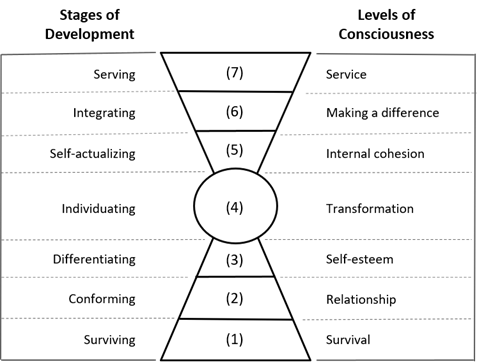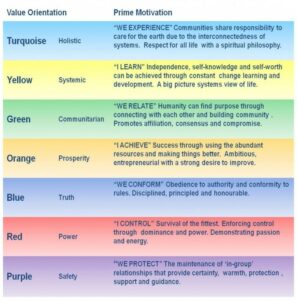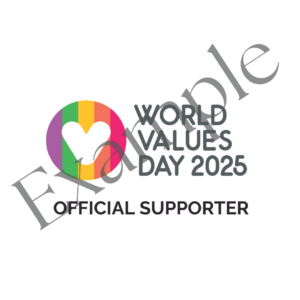By Richard Barrett, Chairman and Founder, Barrett Values Centre
Introduction
In 2010, I wrote a book called The New Leadership Paradigm.[1] In that book, I described the seven levels of leadership consciousness and explained the concept of a full spectrum leadership. I defined a full spectrum leader as someone who was able to handle any situation they had to face from a place of calm, and in a way that benefited the common good. Someone who:
- Can take charge in a crisis
- Finds it easy to connect with people
- Builds high-performing systems and processes
- Empowers people to become all they can become
- You can trust, and who creates an inspirational vision
- Displays empathy and cooperates with others in strategic alliances
- Displays wisdom, compassion, and foresight to build a sustainable future for the organization or community he or she is leading
In this paper, I want to describe the concept of full spectrum consciousness as it applies to a community. The questions I am attempting to answer are, “What does a full spectrum community look like?” and “What are the dominant values in a full spectrum community?”
The Seven Levels Concept
All human beings grow in stages of development and operate at levels of consciousness. [2] Normally, the level of consciousness people operate from will be the same as the stage of development they have reached. The correspondence between the stages of development and levels of human consciousness are shown in Figure 1.
Figure 1: The seven stages of development and the seven levels of consciousness
Stages of development
The age ranges of each stage of human development and the tasks and needs associated with each stage are shown in Table 1.
Table1: The tasks and needs associated with the seven stages of personal development
| Stage of development | Age range | Task | Need |
| Serving | 60+ years | Contributing to the well-being of others. | To be of service to humanity. |
| Integrating | 50–59 years | Connecting in unconditional loving relationships. | To make a difference in your world. |
| Self-actualizing | 40–49 years | Discovering and expressing your gifts and talents. | To find meaning and purpose. |
| Individuating | 25–39 years | Finding freedom to discover who you are. | To feel you can operate with autonomy. |
| Differentiating | 8–24 years | Feeling accepted, respected, and recognized. |
To feel a sense of self-worth. |
| Conforming | 2–8 years | Feeling safe, protected, and loved. |
To feel a sense of belonging. |
| Surviving | 0–2 years | Feeling physically cared for and nurtured. |
To feel in control of your life. |
In a successful community we would expect everyone in the community to experience a sense of well-being.
I define well-being as the feeling you get when you are able to meet the needs of the stage of development you are at. Thus, as a baby, you feel a sense of well-being when their physiological and nurturing needs are met. As a teenager, you feel a sense of well-being when you feel seen and recognized by your parents and your peer group. And so on. When you reach your senior years, you feel a sense of well-being when you are able to contribute in some way to the good of your community.
When you are unable to satisfy the needs of the stage of development you are at you may feel angry, sad or depressed. Table 2 describes the concerns and feelings of people who are not able to meet the needs of the stage of development they are at.
Table 2: Concerns and feelings associated with each stage of development
Successful communities pay attention to the people who have these unmet needs: they constantly monitor the state of being of the different age groups. They identify “at risk” groups and develop programs to support people in getting their needs met no matter what stages of psychological development they area at.
Definition
Based on the foregoing, I define a full spectrum community as one which nurtures all stages of human development. If your community does not nurture all stages of human development; if it fails to care for the needs of children and teenagers, young single adults and young families, middle-aged families and seniors then clearly it cannot be called a full spectrum community.
The values of a full spectrum community
This leads us to the question we posed earlier, “What are the dominant values in a full spectrum community?” To help define these values, I have analysed over half-a-million responses from around the world to the Barrett Values Centre’s Personal Values Assessment. I refer to the top ten values of this group of people as the values of humanity.
The top three values at each level of consciousness are shown below in Table 3. Column three of Table 3 shows the percentage of votes for the three values at each level and column 4 shows the priority.
Table 3: The top three values of half-a-million people at each level of consciousness.
| Level of Consciousness/ Stage of development | Top three values | Percentage of votes for top three values at each level | Priority |
| 7 | Compassion, ethics, humility | 11.22% | 6 |
| 6 | Well-being (PEMS), making a difference, leadership | 13.45% | 4 |
| 5 | Humour/fun, trust, commitment | 18.75% | 2 |
| 4 | Continuous learning, independence, adaptability | 15.36% | 3 |
| 3 | Reliability, ambition, achievement | 11.61% | 5 |
| 2 | Family, caring, respect | 21.35% | 1 |
| 1 | Health, self-discipline, financial stability | 8.27% | 7 |
| 100% |
It is important to recognize that the half-a-million people who filled out the Personal Values Assessment belong to the middle/upper income ranges—they all had access to a personal computer and were interested enough in values to voluntarily participate in this survey. It is also likely they are at, or above, the individuating stage of development.
Priority values
Our values reflect our needs. Whatever we value, is what we need in our lives. Therefore, we can assume that the values of humanity reflect what people want to experience in the community where they live.
The highest priority is Level 2 consciousness. People want to live in communities with strong family ties, where people respect and care for each other. People want to feel safe and protected in their community.
The second highest priority is Level 5 consciousness. People want to be happy and have fun; they want to be able to trust each other and feel there is a high level of commitment to the well-being of the community. They want to feel a sense of social cohesion.
The third highest priority is Level 4 consciousness. People want to feel a sense of independence; they don’t want to live in rigid structures (they want their community to be adaptable), and they want to be able to grow and develop (continuous learning). They want freedom and autonomy to explore who they are.
The fourth highest priority is Level 6 consciousness. People want to experience physical, emotional, mental and spiritual well-being; they want to feel that they can take a lead in making a difference. They want a deeper connection to their inner world and they want to connect with others to support their community.
The fifth and sixth priorities are Level 3 and Level 7 consciousness. People want opportunities to be able to set and achieve the goals they have for their lives and they want to be considered reliable. They want to be able to grow and develop professionally. They also want to live in a compassionate world, where ethics and humility are considered important operating values.
Finally, people prioritize Level 1 consciousness. They want to live in a community where their health needs are taken care of; where they are able to earn a good living, and where people feel responsible for taking care of their needs (self-discipline).
Thus, we can state that in middle/upper income communities the most revered values are:
Health, family, reliability, continuous learning, humour/fun, well-being (physical, emotional, mental and spiritual), and compassion.
[1] Richard Barrett, The New Leadership Paradigm (Fulfilling Books: London), 2010.
[2] Richard Barrett, A New Psychology of Human Well-Being (Fulfilling Books: London), 2017.







